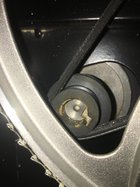Green wood sap and gunk will build up primarily on the inside edge/face of the blade. Some woods more than others. It also builds up on the rubber tires around the wheels and gets be a real mess to deal with as well as make your saw run rough and sound rough. There are other threads here about how to deal with it but it's just part of the process - dealt with and minimized but can't be eliminated. On mine I regularly clean the inside of the blade and tires with the milky colored natural based mineral spirits and a green scotch brite pads. No idea why the "natural" based mineral spirits seems to work best but it works really well and figured less stressful on the rubber tires. Use it liberally on the blade and tires, scrub it and be careful not to pinch your fingers in between the blade and wheels as you spin to clean the gunk off (yep, done it). Check your lower wheel for the brush that sorta makes an attempt at keeping the wheel clean and make sure it's not worn out or too far away to help at least some. Since I've kept an eye on my rear thrust bearings I haven't ruined a blade. All it takes is a split second and if the teeth of a green wood blade hit the side bearings it's game over. You will find lots of very strong opinions on which green wood blade to use from folks who know a lot more than I do but, after a few different types I've been using a 1/2" 3 TPI blade from Olson. Not expensive but seems to work and last much longer than others I've tried. Also, and I have no way to explain it, the gunk buildup on the inside face is far less than others I've used. Probably a combination of sharp teeth and keeping an eye on things vs the blade but, it works better so I keep it.

